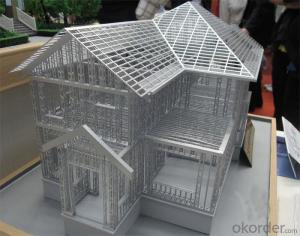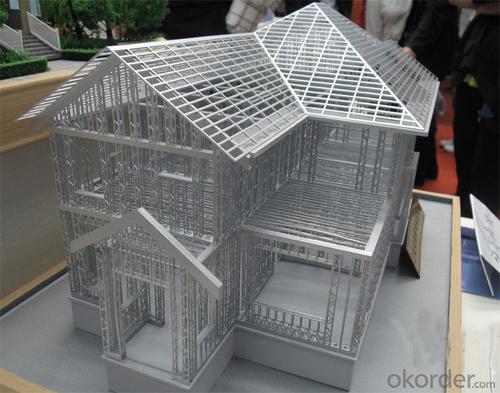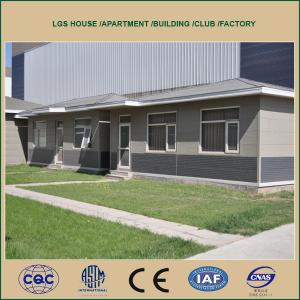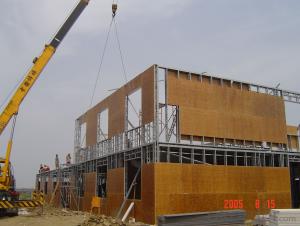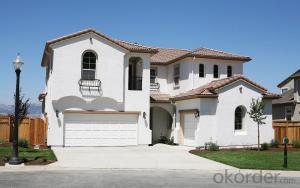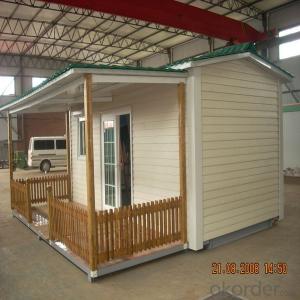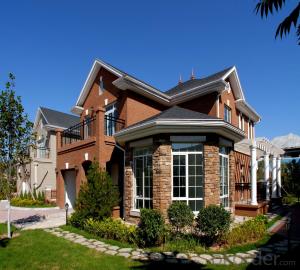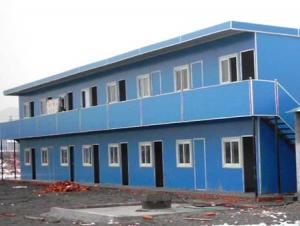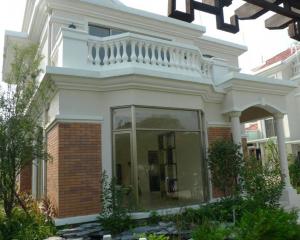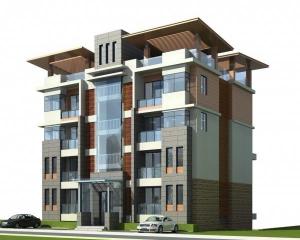Affordable Prefabricated House Made In China
- Loading Port:
- Shanghai
- Payment Terms:
- TT OR LC
- Min Order Qty:
- 1 m²
- Supply Capability:
- 1000 m²/month
OKorder Service Pledge
OKorder Financial Service
You Might Also Like
Affordable Prefabricated House Made In China
PRODUCT PARAMETER
NO. | ITEM | TECNICAL DATA |
1 | galvanized steel | q235/345 |
2 | roof snow load | 1.55kn |
3 | wind load | 50m/s |
4 | life span of main structure | 70 years |
5 | Anti-seismic | 8 degree |
6 | fiber- glass thermal insulation | R19/wall |
7 | fiber-glass thermal insulation | R30/roof |
8 | window | plastic and steel/aluminum. |
PRODUCT FEATURES
1. Eco-friendly
2. Quick to install
3. Seismic resistant
4. Economical
PRODUCT PICTURES
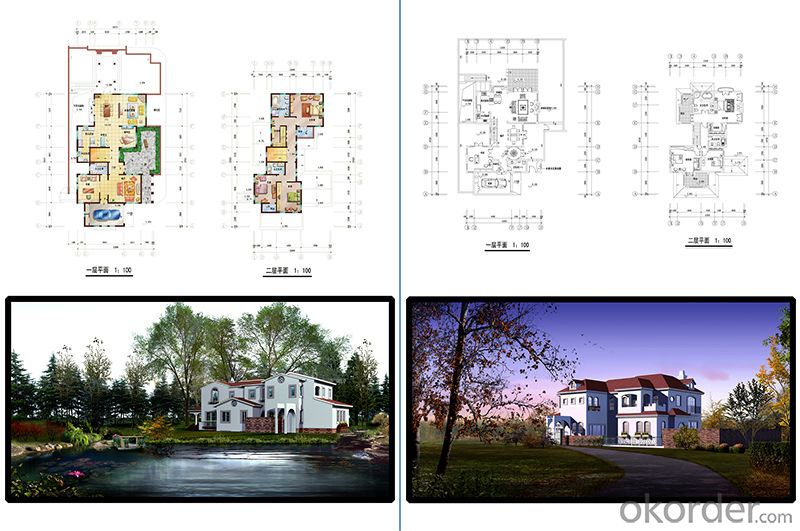
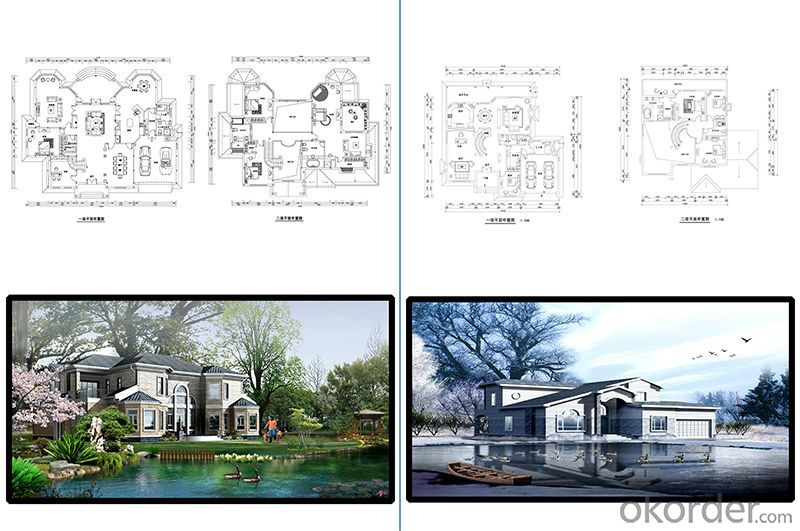

Prefab House Advantage
1. Easy and quick to install;
2. Excellent load and span capabilities;
3. Significant savings in site installation costs;
4. Panel comes in a range of aesthetically pleasuring colors;
5. Energy saving thermal insulation;
6. Superior air tightness for controlled environments;
7. Good reactions to fire properties;
8. Durable, long lasting, stood the test of time in the extremes of harsh climate
- Q: Are container houses suitable for military barracks?
- Container houses are a viable option for military barracks. They possess various advantages that make them an ideal choice for such purposes. To begin with, container houses are a cost-effective alternative. Given the military's limited budget, container houses provide a cost-efficient solution compared to traditional barracks. Containers are readily available and relatively inexpensive, eliminating the need to construct new barracks. Furthermore, their easy modification and transportability reduce construction and relocation expenses. Additionally, container houses offer flexibility and mobility. Military units frequently require relocation or deployment to different areas. Container houses can be effortlessly transported by truck, train, or ship, enabling swift deployment and relocation. This mobility guarantees that military personnel can be accommodated quickly and efficiently, regardless of their location. Moreover, container houses provide durability and security. These containers are constructed to withstand severe weather conditions and offer high levels of security. Made from sturdy steel, they are resistant to extreme temperatures, fire, and even ballistic impacts. This durability ensures the protection of military personnel, allowing them to focus on their duties without concerns about their living conditions. Furthermore, container houses can be tailored to meet specific military requirements. Containers can be modified to include essential amenities like bathrooms, kitchens, and sleeping areas. They can also be connected or stacked to create larger living spaces, accommodating more personnel. This customization optimizes space usage and guarantees suitable living conditions for military personnel. In conclusion, container houses are indeed suitable for military barracks due to their cost-effectiveness, flexibility, mobility, durability, security, and customization options. They provide an efficient and practical solution for military housing, facilitating quick deployment, relocation, and adaptation to specific military needs.
- Q: Are container houses suitable for individuals with allergies or sensitivities?
- Container houses can be a suitable option for individuals with allergies or sensitivities, but it depends on various factors. One advantage of container houses is that they can be built with non-toxic and hypoallergenic materials, reducing the chances of triggering allergies or sensitivities. Additionally, the construction process allows for better control over ventilation, which can help filter out allergens and maintain air quality. However, it is important to consider the source of the container, as some may have been previously used for transporting goods that might have contained allergens or irritants. Proper cleaning and treatment of the container is necessary to ensure it is safe for individuals with allergies or sensitivities. Furthermore, the location and surrounding environment of the container house can greatly impact its suitability for individuals with allergies or sensitivities. If the house is situated in an area with high levels of pollen, dust, or other allergens, it may still pose challenges. Therefore, it is crucial to take into account factors such as the local climate, air quality, and potential for exposure to allergens when considering a container house for someone with allergies or sensitivities. Ultimately, whether a container house is suitable for individuals with allergies or sensitivities will depend on careful consideration of these factors, proper construction techniques, and the use of hypoallergenic materials to create a safe and healthy living environment.
- Q: Can container houses be designed to have a home spa?
- Yes, container houses can certainly be designed to have a home spa. Container houses offer great flexibility and customization options, allowing for the inclusion of various amenities and features, including a home spa. With the right planning and design, container houses can be transformed into luxurious and relaxing spaces that feature spa-like facilities. To create a home spa in a container house, several considerations need to be taken into account. First, the size and layout of the container house should be carefully considered to ensure sufficient space for the spa area. This could involve combining multiple containers or extending the dimensions to accommodate the desired spa features. Next, the plumbing and electrical systems need to be professionally installed to support the spa facilities. This includes water supply and drainage systems for hot tubs, showers, and saunas, as well as appropriate wiring for lighting, heating, and any other electrical spa equipment. In terms of design, container houses can be customized to include various spa elements. For instance, a hot tub or Jacuzzi can be integrated into the outdoor or indoor areas of the container house. Saunas, steam rooms, or relaxation lounges can also be incorporated, depending on the available space and desired spa experience. Furthermore, container houses can be designed with features that promote relaxation and tranquility, such as large windows to let in natural light, soundproofing for a serene environment, and high-quality insulation to maintain optimal temperatures. It is crucial to work with experienced architects and designers who specialize in container house conversions to ensure that the home spa design is not only aesthetically pleasing but also meets all safety and functionality requirements. In summary, container houses can absolutely be designed to have a home spa. With careful planning, proper installation of plumbing and electrical systems, and creative design ideas, container houses can be transformed into luxurious and rejuvenating spaces that offer all the comforts and amenities of a spa.
- Q: Can container houses be designed to have a traditional bedroom layout?
- Yes, container houses can be designed to have a traditional bedroom layout. By utilizing creative interior design techniques and maximizing the available space, container houses can incorporate all the essential elements of a traditional bedroom, including a bed, nightstands, dressers, and even a closet. Although container houses may have limitations in terms of size and shape, with proper planning and design, it is possible to create a comfortable and functional traditional bedroom layout within a container house.
- Q: Are container houses resistant to termites or other wood-damaging insects?
- Yes, container houses are typically resistant to termites and other wood-damaging insects. Since container houses are primarily made of steel, which is not a food source for termites, they are less susceptible to termite infestations compared to traditional wood-framed houses. However, it is still important to ensure proper insulation and sealing to prevent any potential entry points for insects.
- Q: Are container houses suitable for sports facilities or training centers?
- Sports facilities and training centers can indeed benefit from the use of container houses. The versatility and adaptability of these houses are key advantages. They can be easily modified and customized to meet the specific requirements of such facilities. Container houses can be designed to provide ample space for a range of activities, including indoor gyms, fitness studios, and sports courts. The modular nature of container houses allows for easy expansion or reduction of space as needed. This enables the creation of separate areas for different sports or training activities within a single facility. Furthermore, container houses can be equipped with all the necessary amenities and equipment for sports and training purposes. Showers, locker rooms, and storage spaces can all be incorporated. Suitable ventilation and climate control systems can also be installed to ensure a comfortable environment for athletes and trainees. Additionally, container houses are built to be durable and weather-resistant, making them suitable for outdoor sports facilities. They can withstand harsh weather conditions and provide a secure and sturdy structure for sports activities. From a practical perspective, container houses offer cost-effective and time-efficient solutions for sports facilities or training centers. They are relatively affordable compared to traditional construction methods, and their construction and installation can be completed in a shorter timeframe. This makes them particularly suitable for temporary or mobile sports facilities, such as training camps or events. In conclusion, container houses are a viable option for sports facilities or training centers. Their versatility, adaptability, durability, and cost-effectiveness make them an appealing choice for creating functional and practical spaces for various sports and training activities.
- Q: How do container houses compare to tiny houses?
- Container houses and tiny houses have become increasingly popular as alternatives to traditional homes, but they differ in several key aspects. One major distinction lies in the construction material. Container houses are typically constructed from repurposed shipping containers, which are readily available, weather-resistant, and durable. In contrast, tiny houses can be built using various materials, including wood, metal, or even recycled materials. This allows for greater design flexibility and aesthetic choices. Regarding size, container houses generally offer more space compared to tiny houses due to the larger base provided by shipping containers. A typical container house ranges from 160 to 320 square feet, while tiny houses are usually smaller, ranging from 80 to 400 square feet. This difference in size can significantly impact the layout and functionality of the living space. Another difference can be found in mobility. Tiny houses are often built on wheels, making them easily transportable and relocatable. This mobility makes them an excellent option for individuals seeking a nomadic lifestyle or the freedom to move their residence to different locations. Conversely, container houses are typically more stationary due to their heavy and fixed structure. Although they can be moved with effort and logistical planning, it is a more challenging process. Cost is another factor to consider. Container houses are generally more cost-effective than tiny houses due to the relatively low price of shipping containers themselves. However, customization, insulation, plumbing, and other amenities can drive up the overall cost. On the other hand, the price of tiny houses can vary significantly depending on the chosen materials, level of customization, and location of construction. Finally, both container houses and tiny houses offer unique sustainability benefits. Container houses promote recycling and repurposing by giving shipping containers a second life. Tiny houses, on the other hand, often incorporate energy-efficient features and can utilize renewable energy sources, such as solar panels, to minimize their environmental impact. In conclusion, container houses and tiny houses each offer distinct advantages and disadvantages. Container houses excel in terms of durability, size, and cost-effectiveness, while tiny houses provide mobility and design flexibility. Ultimately, the choice between the two depends on personal preferences, lifestyle, and specific needs.
- Q: How do container houses compare to traditional houses in terms of construction time?
- Container houses tend to have a shorter construction time compared to traditional houses. Since container homes are built using pre-fabricated shipping containers, the assembly and construction process is typically faster. Traditional houses, on the other hand, involve more complex and time-consuming construction methods, resulting in a longer construction timeline.
- Q: Are container houses easy to transport during the construction process?
- Container houses are known for their ease of transportation during construction. The key advantage of using shipping containers for housing lies in their portability. These containers are specifically designed to be transported across great distances on ships, trains, and trucks, making them highly mobile. During the construction process, container houses can be effortlessly transported to the desired location using trucks or cranes. This eliminates the need for extensive on-site construction and enables faster and more efficient building. Moreover, since the containers are already built to withstand transportation stresses, their structural integrity remains intact even during movement. Additionally, container houses can be easily disassembled and relocated to a new site if necessary. This flexibility is particularly attractive for individuals or organizations in need of temporary or mobile housing solutions. Nevertheless, it is important to consider that the ease of transportation may vary depending on the container house's size, weight, and the accessibility of the construction site. In certain cases, specialized equipment or permits may be required to transport larger or heavier container houses. Nonetheless, overall, container houses provide a convenient and practical solution for portable housing.
- Q: Can container houses be easily modified or remodeled?
- Yes, container houses can be easily modified or remodeled due to their modular nature. The ability to stack, interlock, and dismantle containers provides flexibility in design changes or expansions. Additionally, their steel structure allows for easy cutting and welding, enabling modifications such as adding windows, doors, or partitions.
Send your message to us
Affordable Prefabricated House Made In China
- Loading Port:
- Shanghai
- Payment Terms:
- TT OR LC
- Min Order Qty:
- 1 m²
- Supply Capability:
- 1000 m²/month
OKorder Service Pledge
OKorder Financial Service
Similar products
Hot products
Hot Searches
Related keywords
